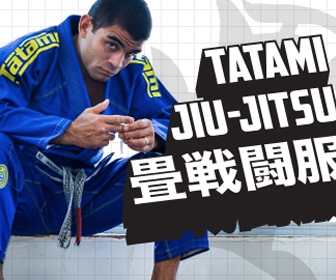Jiu-Jitsu and Submission-Grappling are complex sports with many intricacies at a macro and micro level. The answer to “Which is the best style for competitive success?” requires a layered answer reliant on a variety of vectors such as the tournament’s rulesets, and an individual’s athleticism/body style, gamesmanship, etc. Nevertheless, we can always philosophize and raise awareness of the data when it points in a given direction.
In this study, we will be laying out a few stats that shine a light on one of the most common submissions in our sport, the heel hook. A position that took jiu-jitsu by storm in the mid-2010s thanks to the outstanding work of the (now extinct) Danaher Death Squad workgroup of coach John Danaher in the sport’s no-gi circuit, which has since blossomed into a worldwide trend.
To understand how important this attack is, take a look at the most used submissions over the past 3 editions of the ADCC World Championships:
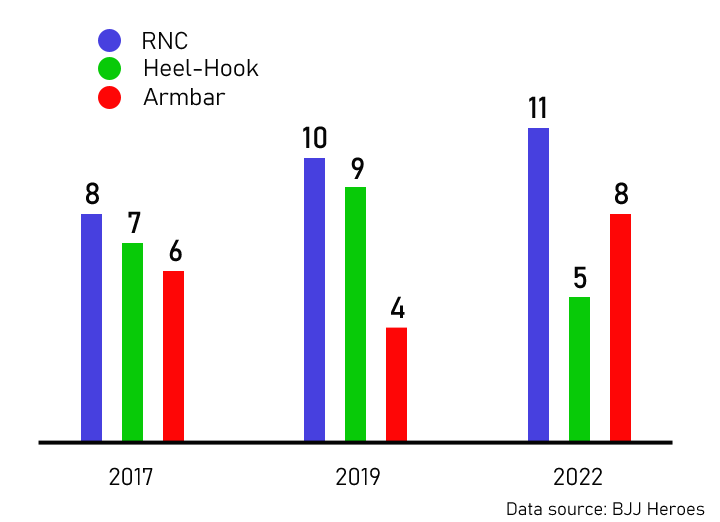
At BJJ Heroes we watch hundreds of matches per week and grappling patterns often pop up. One that is commonly observed is a leg entanglement started by, say, Athlete A intending to force a heel-hook on Athlete B, but it is “B” who ends up leg-locking the initiator with a counterattack. This is not seen solely in lesser submission artists but in heel-hook specialists – think Eoghan O’Flanagan vs Giancarlo Bodoni, Mica Galvao vs Kade Ruotolo at ADCC 2022, Jeremy Skinner vs Reese Lefever at Enigma Invitational 2023, and so on. All high-level heel hook specialists who lost to a counter while attempting their own. This trend appeared anecdotal at first but further inspection revealed surprising results.
To better understand the real-world vulnerability of a leg-locker and the possibility of himself ending up at the wrong end of the feet exchange, we assessed 4 major submission-grappling events, namely the ADCC World Championships of 2022, 2019, & 2017, as well as the IBJJF World No-Gi Championships of 2022. The results might shock you.
Who Won The Leg Lock Battle, The Athlete Initiating The Attack, or The One Being Attacked?
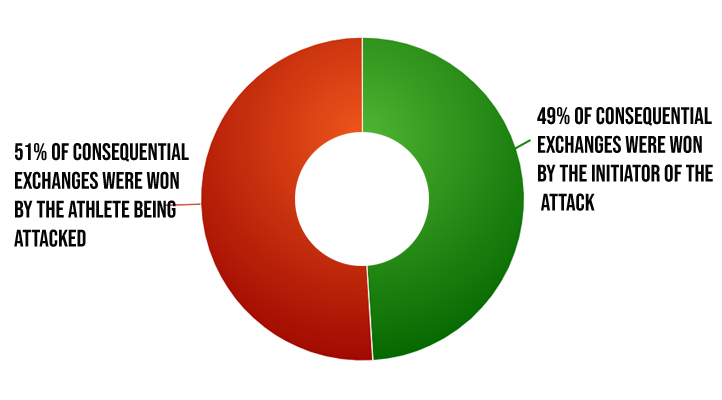 More than half of the athletes who initiated the foot attack ended up losing the battle either by being submitted or by being scored on at the end of the exchange. These are very substantial numbers at the pro level of our sport as we are yet to see any other position as widespread as this offering such diminished returns.
More than half of the athletes who initiated the foot attack ended up losing the battle either by being submitted or by being scored on at the end of the exchange. These are very substantial numbers at the pro level of our sport as we are yet to see any other position as widespread as this offering such diminished returns.
It is important to explain that we only accounted for leg entanglements that were of consequence. Meaning, leg entanglements that ended with a point or a submission at the end of the sequence for either athlete. Attempts that led to no advancement were left out of this graph.
LEG ENTANGLEMENTS & OUTCOMES
No assessment of heel hook performance would be complete without addressing the leg entanglements that allow the attacker the necessary leverage and protection (or lack thereof) to force the desired outcome. So, which offered the most success?
Most Utilized Leg Entanglements at ADCC & IBJJF No-Gi World Championships:
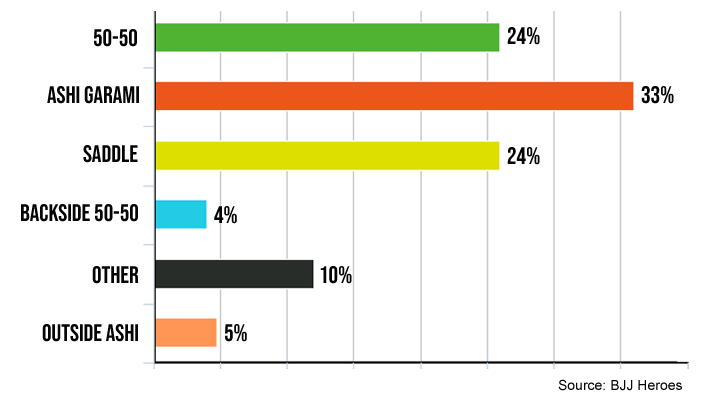 Doing a deeper dive into the positions applied, we looked at the outcome of the exchanges. Meaning, which controls performed better.
Doing a deeper dive into the positions applied, we looked at the outcome of the exchanges. Meaning, which controls performed better.
To make matters simpler, we addressed the top 3 performing controls applied which showed the Saddle as the most efficient position, albeit, without particularly exciting numbers. 62% success rate for the athlete initiating the exchange.
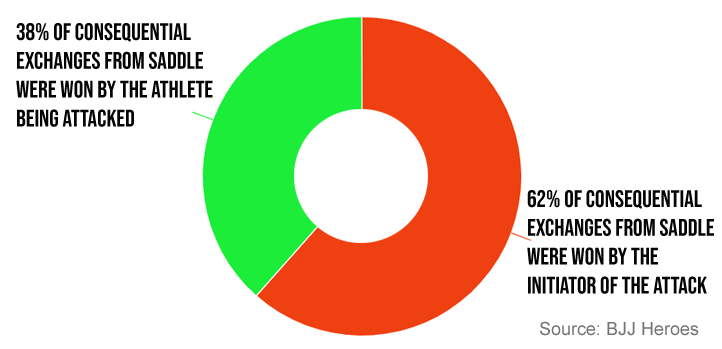
Although widely used, the 50-50 guard – as the name suggests – leaves both athletes with similar access to each other’s legs. Interestingly, this dynamic proved to be much more favorable for the person initially defending the attack rather than the person who started the attack, with the stats showing only 38% of the finishes being accomplished by the initiator (!). A very eyebrow-raising number.
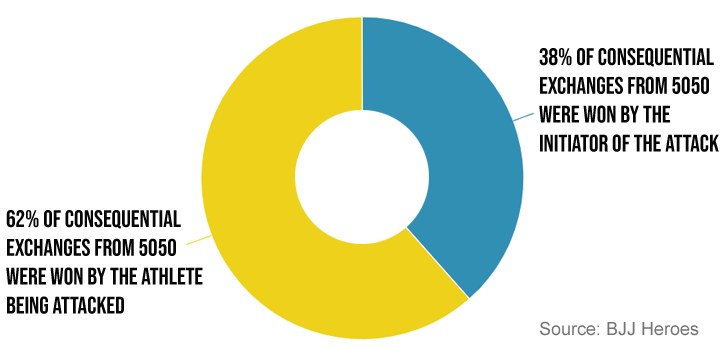
Another popular leg entanglement that showed surprising sub-par results for the initiator of the attack was the Ashi-Garami. In this case, only 44% of the athletes that started the attack achieved success, with the defenders winning 56% of the Ashi exchange via, either finish, back-take, or sweep.
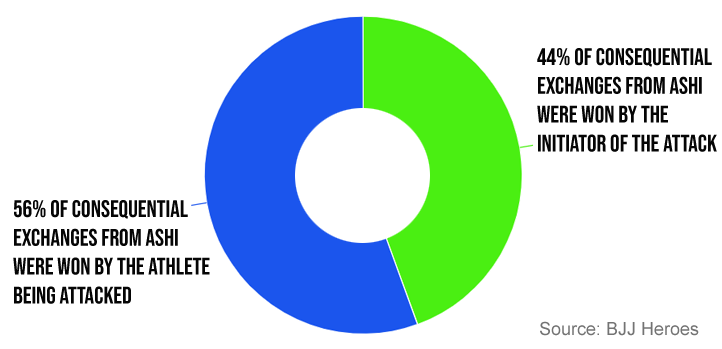
It is important to point out that not all of the outcomes of these leg entanglements ended in a submission. As aforementioned earlier in this article, in this heel hook study, we accounted for every heel-hook exchange that produced an instance, meaning, either a submission or a score via sweeps, back-take, and whatnot. The outcomes of these exchanges produced the following percentages:

ARE HEEL HOOKS WORTH LEARNING?
Given how the numbers point to such high risk in undertaking leg-lock battles, the question should be: Is it worth focusing on heel hooks?
Over the years competition has taught us how important it is to be able to surprise your opponents with new techniques. From Maurício ‘Tinguinha’ and the group that developed the Spider Guard for jiu-jitsu in the late 1980s to the Mendes Brothers and their use of the 50-50 Guard & Leg Drag as well as the Berimbolo, Crab-Ride, and so many other trends that have come and gone.
As athletes adapt to the new techniques, new ones are developed in a revolving door of grappling evolution. Some techniques remain (like the 50-50 which is still prevalent), while others fall out of use, like the berimbolo, which has only been performed successfully twice in the last two years at the black belt level in the World & Pan Championships.
Currently, the heel hook is still very much in use, there is no question about that and we don’t see it disappearing from the sport’s mainstream. It has been consistently among the top 3 most used submissions in the ADCC’s World Championships, and it has not shown any signs of disappearing into the night. It is also worth pointing out that the position is only being countered because athletes have learned the dynamics of this attack and are now able to defend/counter it.
Although this submission is very common and there is a long list of competitors who have focussed their whole games around this type of attack, none of these single-game specialists have made it through at the highest level in the sport, the ADCC World Championships, where the prototype of success is still a well-rounded athlete who works mostly from a top position with solid footlock defense as well as a more sniper approach to leg locks, just a glance at the current ADCC champions will tell you that, i.e. Diogo Reis, Kade Ruotolo, Giancarlo Bodoni, Gordon Ryan, Yuri Simoes, etc.
In sum, in our opinion any successful grappling program needs to include heel-hooks but it would likely benefit from it not being the main focus of the course.
The cover photo was taken by Kenny Jewel of GrappleTv.







